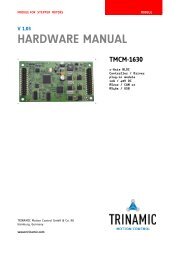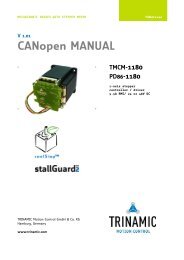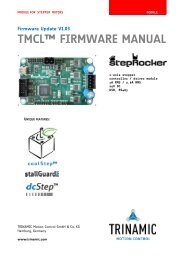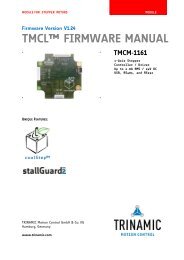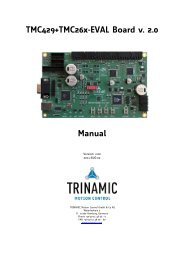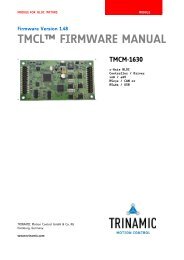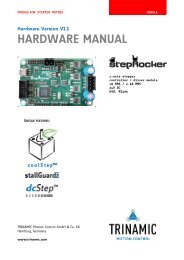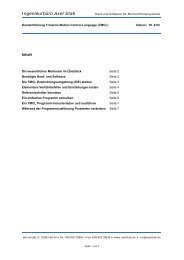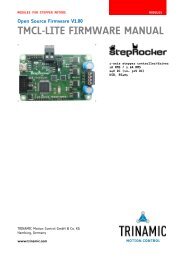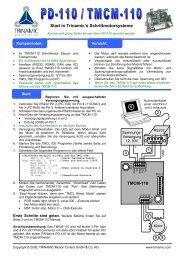TMC429 & TMC26x Getting Started: Motion Control via ... - Trinamic
TMC429 & TMC26x Getting Started: Motion Control via ... - Trinamic
TMC429 & TMC26x Getting Started: Motion Control via ... - Trinamic
You also want an ePaper? Increase the reach of your titles
YUMPU automatically turns print PDFs into web optimized ePapers that Google loves.
POWER DRIVER FOR STEPPER MOTORS INTEGRATED CIRCUITS<br />
<strong>TMC429</strong> & <strong>TMC26x</strong> <strong>Getting</strong> <strong>Started</strong>:<br />
<strong>Motion</strong> <strong>Control</strong> <strong>via</strong> Step/Direction<br />
Valid for TMC260, TMC261, and TMC262<br />
Here, <strong>TMC26x</strong> represents TMC262, TMC261, or TMC260 because they behave identical from the register<br />
communication point of view.<br />
This application note describes how to initialize a <strong>TMC429</strong> together with a <strong>TMC26x</strong> with basic parameters<br />
to run a stepper motor.<br />
Additional application notes are available for more advanced parameterization of the <strong>TMC26x</strong> stepper<br />
motor driver and for parameterization of stallGuard and coolStep.<br />
Table of Contents<br />
1 Preliminary Note ........................................................................................................................................................... 1<br />
2 Hardware Architecture Outline ................................................................................................................................. 2<br />
3 Source Code Examples and Software Architecture ............................................................................................ 2<br />
4 Initialization of the <strong>TMC26x</strong> ...................................................................................................................................... 3<br />
5 Initialization of the <strong>TMC429</strong> ...................................................................................................................................... 4<br />
5.1 <strong>TMC429</strong> Configuration RAM – for SPI Stepper Driver Only .............................................................................. 4<br />
5.2 <strong>TMC429</strong> Configuration Step/Direction Interface & Timing ............................................................................... 4<br />
5.3 <strong>TMC429</strong> Step/Direction Timing – Set clk2_div in Global Parameter Register ............................................. 5<br />
5.4 Parameterizing Individual Stepper Motors for <strong>Motion</strong> ..................................................................................... 7<br />
5.5 Running a Motor ........................................................................................................................................................ 10<br />
6 Summary ....................................................................................................................................................................... 11<br />
7 Disclaimer ..................................................................................................................................................................... 11<br />
8 Revision History .......................................................................................................................................................... 11<br />
8.1 Document Revision .................................................................................................................................................... 11<br />
9 References .................................................................................................................................................................... 11<br />
1 Preliminary Note<br />
For explaining how to initialize a <strong>TMC429</strong> together with a <strong>TMC26x</strong> the stepRocker module TMCM-1110<br />
is used as actual example. C source code examples are freely available for this module for practical<br />
tests (www.steprocker.com).<br />
TRINAMIC <strong>Motion</strong> <strong>Control</strong> GmbH & Co. KG<br />
Hamburg, Germany
Application Note 016 (V1.02 / 2012-AUG-02) 2<br />
2 Hardware Architecture Outline<br />
From the configuration point of view, the <strong>TMC429</strong> and TMC262 of the stepRocker have the<br />
architecture outlined in Figure 1. The motion control of the TMC262 takes place <strong>via</strong> step/direction by<br />
the <strong>TMC429</strong>. Both, the <strong>TMC429</strong> and the TMC262 are parameterized <strong>via</strong> SPI by the microcontroller.<br />
CLK_TMC<br />
MISO_1<br />
MOSI_1<br />
SCK_1<br />
nSCS_429<br />
CSN_262<br />
www.trinamic.com<br />
CLK<br />
SDOZ_C<br />
SDI_C<br />
SCK_C<br />
nSCS_C<br />
<strong>TMC429</strong><br />
nSCS2_S3<br />
nSCS3_D3<br />
nSCS_S_S2<br />
SDI_S_D2<br />
SDO_S_S1<br />
SCK_S_D1<br />
Figure 1 SPI and step/dir wiring scheme for <strong>TMC429</strong> with TMC262 on stepRocker module<br />
3 Source Code Examples and Software Architecture<br />
The complete firmware of the stepRocker (www.steprocker.com) is available as C source code<br />
example on www.trinamic.com from the stepRocker page <strong>via</strong> a link to stepRocker open TMCL<br />
Library (github).<br />
STP<br />
DIR<br />
SDO<br />
SDI<br />
SCK<br />
CSn<br />
TMC262<br />
The main program is stepRocker.c calling all necessary initializations.<br />
Please refer the HTML documentation generated from source code with doxygen concerning details<br />
of firmware architecture source code.
Application Note 016 (V1.02 / 2012-AUG-02) 3<br />
4 Initialization of the <strong>TMC26x</strong><br />
For configuration, the <strong>TMC26x</strong> has five control registers: DRVCTRL (Driver <strong>Control</strong>), CHOPCONF<br />
(Chopper Configuration), SMARTEN (Smart Energy), SGCSCONF (stallGuard2, Current Scale), and<br />
DRVCONF (driver configurations).<br />
Note: - Smart Energy is an early term for coolStep.<br />
- An application note concerning optimal chopper configuration is available. For getting<br />
started a default configuration as given here is sufficient to start a motor running.<br />
- An application note concerning the parameterization of stallGuard2 and coolStep is also<br />
available. For getting started the stallGuard2 and coolStep features will not be used. This<br />
is proposed to be done later.<br />
LIST OF IMPORTANT CONTROL REGISTERS:<br />
DRVCTRL: driver control parameter, here SDOFF=0 (default) step-direction = ON<br />
CHOPCONF: chopper configuration register<br />
SMARTEN: coolStep. Leave untouched for getting started<br />
SGCSCONF: stallGuard2. Ignored for getting started, but setting current scale is required<br />
DRVCONF: basic driver configurations switches<br />
TMC26X REGISTER CONFIGURATION EXAMPLE<br />
Register/<br />
Bit<br />
www.trinamic.com<br />
DRVCTRL<br />
(SDOFF=1)<br />
DRVCTRL<br />
(SDOFF=0)<br />
CHOPCONF<br />
SMARTEN<br />
SGCSCONF DRVCONF<br />
19 0 0 1 1 1 1<br />
18 0 0 0 0 1 1<br />
17 PHA - 0 1 0 1<br />
16 CA7 - TBL1=1 0 SFILT=1 TST=0<br />
15 CA6 - TBL0=0 SEIMIN=0 - SLPH1=1<br />
14 CA5 - CHM=0 SEDN1=0 SGT6=0 SLPH0=1<br />
13 CA4 - RNDTF=0 SEDN0=0 SGT5=0 SLPL1=1<br />
12 CA3 - HDEC1=0 - SGT4=0 SLPL0=1<br />
11 CA2 - HDEC0=0 SEMAX3=0 SGT3=0 -<br />
10 CA1 - HEND3=0 SEMAX2=0 SGT2=1 DISS2G=0<br />
9 CA0 INTPOL=0 HEND2=0 SEMAX1=0 SGT1=0 TS2G1=0<br />
8 PHB DEDGE=0 HEND1=1 SEMAX0=0 SGT0=1 TS2G0=0<br />
7 CB7 - HEND0=0 - - SDOFF=0<br />
6 CB6 - HSTRT2=0 SEUP1=0 - VSENSE=1<br />
5 CB5 - HSTRT1=1 SEUP0=0 - RDSEL1=0<br />
4 CB4 - HSTRT0=1 - CS4=0 RDSEL0=0<br />
3 CB3 MRES3=0 TOFF3=0 SEMIN3=0 CS3=0 -<br />
2 CB2 MRES2=0 TOFF2=0 SEMIN2=0 CS2=1 -<br />
1 CB1 MRES1=0 TOFF1=0 SEMIN1=0 CS1=0 -<br />
0 CB0 MRES0=0 TOFF0=1 SEMIN0=0 CS0=1 -<br />
Table 4.1 <strong>TMC26x</strong> register configuration table example<br />
SPI DATAGRAMS TO WRITE THE TMC26X REGISTER CONFIGURATION GIVEN IN THE EXAMPLE<br />
DRVCTRL = 0x00000; // set interpolation = OFF, micro step resolution = 256x<br />
CHOPCONF = 0x90131; // set TBL=3, CHM=0, RNDTF=0, TOFF=1<br />
SMARTEN = 0xA0000; // disable smart energy function (coolStep)<br />
SGCSCONF = 0xD0505; // set CS=0x05 that is 0x5/0x1F = 5/31 = 16% of max. current<br />
DRVCONF = 0xEF040; // set driver configuration & step/direction control<br />
The initialization of the driver is handled by the routine <strong>TMC26x</strong>.c: void InitMotorDrivers(void);<br />
Within the C source code example, the <strong>TMC26x</strong> control bits are stored within a data record that<br />
holds all control bits. The access is handled in a way that one can read back the actual settings from<br />
that data record. This is because the <strong>TMC26x</strong> allows reading back status information but written<br />
configuration bits are write only and cannot be read back.
Application Note 016 (V1.02 / 2012-AUG-02) 4<br />
5 Initialization of the <strong>TMC429</strong><br />
5.1 <strong>TMC429</strong> Configuration RAM – for SPI Stepper Driver Only<br />
This application note describes how to control a <strong>TMC26x</strong> <strong>via</strong> step-direction signals. For step/direction<br />
control the <strong>TMC429</strong> configuration RAM is unused and the internal sine wave look-up table (SinLUT)<br />
of the <strong>TMC26x</strong> driver is used instead. So, there is no need for initialization of the <strong>TMC429</strong><br />
configuration RAM.<br />
5.2 <strong>TMC429</strong> Configuration Step/Direction Interface & Timing<br />
ACTIVATING THE STEP/DIRECTION INTERFACE<br />
The step/direction interface of the <strong>TMC429</strong> is activated by setting the ENable StepDirection control bit<br />
EN_SD = 1 of the <strong>TMC429</strong> configuration register named if_configuration_429.<br />
TIMING OF THE STEP/DIRECTION INTERFACE<br />
The timing of the step/direction interface of the <strong>TMC429</strong> is programmed <strong>via</strong> the nibble clk2_div [3…<br />
0]. This are the bits [11… 9] of the stepper motor global parameter register.<br />
The programming of the timing is intended for use of external step/direction power stages. For local<br />
communication the timing needs to be programmed to the fastest setting that is clk2_div = 0000.<br />
5.2.1 if_configuration_429 (JDX=%0100) and Step/Direction Timing <strong>via</strong><br />
CLK2_DIV<br />
The register if_configuration_429 is the interface configuration register for the <strong>TMC429</strong>. This register<br />
is used for<br />
- configuration of the additional reference inputs,<br />
- de-multiplexed interrupt output,<br />
- step/direction interface, and for<br />
- association of the position compare output signal to one stepper motor.<br />
Register/ Bit if_configuration_429 Function<br />
0 INV_REF = 0 Invert polarity of reference switches (common polarity for<br />
all reference switches.<br />
1 SDO_INT = 1 Map internal non-multiplexed interrupt status to<br />
nINT_SDO_C (needs SDOZ_C as SDO_C for read back<br />
information from the <strong>TMC429</strong> to the micro controller); with<br />
SDO_INT='1' the nINT_SDO_C is a non-multiplexed nINT<br />
output to the micro controller<br />
2 STEP_HALT = 0 Toggle on each step pulse (this halfs the step frequency,<br />
both pulse edges represent steps); this function can be used<br />
for the TMC262; STEP_HALF reduces the required step pulse<br />
bandwidth and is use full if one used e.g. low-bandwidth<br />
opto-couples;<br />
3 INV_STP = 0 Invert step pulse polarity; this is for adaption of the step<br />
polarity to external diver stages<br />
4 INV_DIR = 0 Invert step pulse polarity; this is for adaption to external<br />
diver stages; alternatively, this can be used as a shaft bit to<br />
adjust the direction of motion for a motor, but do not use<br />
this as a direction bit because it has no effect on the<br />
internal handling of signs (x_actual, v_actual, …)<br />
5 EN_SD = 1 ENable StepDirection. Important Hint: The Step Pulse Timing<br />
(length) must be compatible with step frequency; the Step<br />
Pulse Timing is determined by the 4 LSBs of CLK2_DIV for<br />
when step/direction mode is selected by ED_SD='1';<br />
www.trinamic.com
Application Note 016 (V1.02 / 2012-AUG-02) 5<br />
Register/ Bit if_configuration_429 Function<br />
6 POS_COMP_SEL_0 = 0 Select one motor out of three motors (%00, %01, %10) for<br />
7 POS_COMP_SEL_1 = 0 the position compare function output of the <strong>TMC429</strong> named<br />
poscmp.<br />
8 EN_REFR = 1 Enable new <strong>TMC429</strong> reference inputs REFR1, REFR2, REFR3.<br />
EN_REFR=0 is the default. This is important because the<br />
REFRx input have internal pull-up resistors and this might<br />
cause trouble if these in-out are not-connected (for the<br />
SSOP16 these REFRx cannot be connected).<br />
Table 5.1 Example of if_configuration_429 interface configuration register setting for <strong>TMC429</strong><br />
SPI DATAGRAMS TO WRITE THE TMC26X REGISTER CONFIGURATION GIVEN IN THE EXAMPLE:<br />
if_configuration_429 = 0x680122; // write JDX=4 with SDO_INT=1, EN_SD=1, EN_REFR=1<br />
The initialization of the <strong>TMC429</strong> is handled by the routine <strong>TMC429</strong>.c : void Init429(void);<br />
5.3 <strong>TMC429</strong> Step/Direction Timing – Set clk2_div in Global<br />
Parameter Register<br />
The step/direction mode is enabled while the ENable StepDirection control bit EN_SD of the<br />
if_configuration_429 register is set to 1.<br />
The timing of the step/direction interface is controlled by the four LSBs [3… 0] of the clk2_div of the<br />
global parameter register.<br />
The clk2_div [3… 0] is named stpdiv_429. For a given clock frequency fCLK [unit: MHz] of the <strong>TMC429</strong>,<br />
the length tSTEP [unit: µs] of a step pulse is<br />
tSTEP [µs] = 16 * ( 1 + stpdiv_429 ) / fCLK [MHz].<br />
For a clock frequency fCLK [MHz] of 16MHz the step pulse length can be programmed by stpdiv_429<br />
in integer multiple of 1 µs.<br />
The stpdiv_429 must be set that it is compatible to the upper step frequency fSTEP = 1 / tSTEP that<br />
is used.<br />
The first step pulse after a change of direction is delayed by tDIR2STP that is equal to tSTEP to avoid<br />
setup time violations of the step/direction power stage.<br />
Note:<br />
- The maximum step pulse frequency is fSTEP_MAX [MHz] = fCLK [MHz] / 32.<br />
- For a clock frequency fCLK [MHz] = 16MHz the maximal possible step pulse frequency fSTEP_MAX is<br />
500kHz.<br />
- For a clock frequency fCLK [MHz] = 32MHz the maximal step pulse frequency fSTEP_MAX is 1MHz.<br />
DIR<br />
STP<br />
www.trinamic.com<br />
tDIR2STP = tSTEP<br />
tSTEP<br />
tDIR2STP = tSTEP<br />
tSTEP<br />
Figure 2: <strong>TMC429</strong> Step/direction timing (EN_SD='1' & STEP_HALF='0')
Application Note 016 (V1.02 / 2012-AUG-02) 6<br />
For SD_EN = 1 the clk2_div [3… 0] is named stpdiv_429 within the <strong>TMC429</strong> datasheet (available on<br />
www.trinamic.com). In step/direction mode the other control bits of the stepper motor global<br />
parameter register are ignored. For setting the fastest step/direction timing write 0 in the stepper<br />
motor global parameter register with<br />
stepper_motor_global_parameter_register = 0x7E000000; // clk2_div = O resp. stpdiv_429 = 0<br />
This initialization of the <strong>TMC429</strong> is also handled by the routine <strong>TMC429</strong>.c : void Init429(void);<br />
Generally:<br />
For short wire link between <strong>TMC429</strong> and <strong>TMC26x</strong> of the step/direction signals (e.g. on TMCM-1110<br />
stepRocker board) one can set the shortest tSTEP be setting stpdiv_429 = 0.<br />
EXCERPT OF STEPPER MOTOR GLOBAL PARAMETER REGISTER<br />
Register/ Bit<br />
www.trinamic.com<br />
Stepper motor global<br />
parameter register<br />
Function<br />
23<br />
22<br />
21 mot1r For SD_EN = 1 of in if_configuration_429 this control bit<br />
is ignored.<br />
20 refmux For SD_EN = 1 of in if_configuration_429 this control bit<br />
is ignored.<br />
19<br />
18<br />
17<br />
16<br />
15<br />
14<br />
13<br />
12<br />
11<br />
10<br />
9<br />
8<br />
7<br />
6<br />
5<br />
4<br />
3<br />
2<br />
1<br />
0<br />
continuous_update<br />
clk2_div [7…4]<br />
clk2_div [3…0] = 0<br />
csCommonIndividual<br />
polarities<br />
LSDM = 00, 01, 10<br />
For SD_EN = 1 of in if_configuration_429 this control bit<br />
is ignored.<br />
For SD_EN = 1 of in if_configuration_429 this part of the<br />
register is ignored.<br />
For SD_EN = 1 of in if_configuration_429 this defines the<br />
timing of the step/direction interface; setting to O for<br />
fastest timing.<br />
For SD_EN=1 of in if_configuration_429 this part of the<br />
register is ignored<br />
Polarities of the SPI signals for the SPI stepper motor<br />
driver chain.<br />
Not relevant for step/direction mode of <strong>TMC429</strong><br />
Last stepper motor driver.<br />
Not relevant for step/direction mode of <strong>TMC429</strong><br />
Table 5.2 Example of stepper motor global parameter register for <strong>TMC429</strong> step/direction timing
Application Note 016 (V1.02 / 2012-AUG-02) 7<br />
5.4 Parameterizing Individual Stepper Motors for <strong>Motion</strong><br />
The preceding basic initializations of interfacing normally need to be done only once. Now, proceed<br />
as follows:<br />
- Choose and set the motion parameters v_min and v_max.<br />
- Choose and set the clock pre-dividers pulse_div and ramp_div.<br />
- Choose and set the microstep resolution usrs.<br />
- Set a_max with a valid pair of pmul and pdiv.<br />
- Choose the switch configuration ref_conf with the ramp mode rm.<br />
- Pull down to ground or disable the reference switch inputs REF1, REF2, REF3 plus REF1R,<br />
REF2R, and REF3R by setting ref_conf.<br />
5.4.1 Choose x_target (for Ramp Mode) or v_target (for Velocity<br />
Mode)<br />
With the above mentioned settings the <strong>TMC429</strong> runs a motor if one writes either x_target or<br />
v_target, depending on the choice of the ramp mode rm.<br />
Each stepper motor has its associated set of registers for motion control. Before running a motor,<br />
parameters have to be initialized. For many applications there is no need to re-program settings<br />
done once during initialization.<br />
MODES OF OPERATION:<br />
The parameters mentioned here allow the adjustment for a wide range of applications.<br />
- For ramp_mode the microcontroller sends desired target positions x_target and the <strong>TMC429</strong><br />
autonomously takes care of positioning.<br />
- For velocity_mode, the micro controller sends the desired target velocity v_target to the<br />
<strong>TMC429</strong> to run a stepper motor continuously with that speed.<br />
All motion control parameters are represented as integer resp. signed integer values within units<br />
that are specific for the <strong>TMC429</strong> (depending on the clock frequency used for the <strong>TMC429</strong>).<br />
5.4.2 Real World Units, Units of Stepper Motors, and <strong>TMC429</strong> Internal<br />
Units<br />
From the stepper motor application point of view, motion control parameters within units of<br />
fullsteps (FS) for position, fullsteps per second (FS/s) for velocity, and fullsteps per second square<br />
(FS/s^2) for acceleration are natural units for stepper motors. The formulas to calculate into these<br />
units are given in the <strong>TMC429</strong> datasheet section pulse_div & ramp_div & usrs (IDX=%1100).<br />
The following calculation files are available on www.trinamic.com (on <strong>TMC429</strong> product page):<br />
- tmc429_frequencies.xls spread sheet, which calculates between physical motion units (rad, rad/s…)<br />
and stepper specific units (FS, FS/s, …)* 1<br />
- <strong>TMC429</strong>Calc.exe standalone program* 2<br />
* 1 The link between real world units and stepper motor units in full step units is an application specific gear ration that<br />
defines how distances (in meters, inches…) or angels (radians, grad…) match with one full step.<br />
* 2 The link between time in seconds and <strong>TMC429</strong> units is done <strong>via</strong> lengths of internal counter and the clock frequency fCLK<br />
[MHz] of the <strong>TMC429</strong>.<br />
www.trinamic.com
Application Note 016 (V1.02 / 2012-AUG-02) 8<br />
5.4.3 Velocity R [Hz] and Acceleration R [Hz/s]<br />
The desired microstep frequency R [Hz] and the desired microstep acceleration R [Hz] depend on<br />
the application. Typical stepper motors can go up to fullstep frequencies of some thousand fullsteps<br />
per second. Without load, they can accelerate to those fullstep frequencies within a couple of<br />
fullsteps.<br />
5.4.3.1 Choosing Microstep Resolution / Step Pulse Pre-Divider / Acceleration<br />
Pre-Divider<br />
Microstep resolution, step pulse pre-divider, and acceleration pre-divider have to be set according to<br />
the following procedure.<br />
1. CHOOSE THE MICROSTEP RESOLUTION<br />
First, set a microstep resolution. It is assumed that the highest microstep resolution usrs = 6 for the<br />
driver motion control of the SPI driver chain is set. In step/direction mode the microstep resolution<br />
is controlled within the driver chip and should be taken into account.<br />
2. SET THE STEP PULSE PRE-DIVIDER<br />
Then, the pulse pre-divider has to be determined. It allows scaling the step frequencies in a very<br />
wide range. Therefore take into account the maximum desired velocity v_max. Based on the formula<br />
R [Hz] = f_clk [Hz] * velocity / ( 2^pulse_div * 2048 * 32 ) given within the <strong>TMC429</strong> datasheet one can<br />
determine<br />
pulse_div := log( f_clk [Hz] * v_max / ( R [Hz] * 2048 * 32 ) ) / log(2)<br />
setting v_max = 2047 (or 2048 for simplified calculation) and R [Hz] to the maximum desired<br />
microstep frequency.<br />
The fullstep frequency can be calculated based on the formula R FS [Hz] = R [Hz] / 2^usrs given within<br />
the <strong>TMC429</strong> data sheet. With this, the microstep frequency is R [Hz] = R FS [Hz] * 2^usrs. The quotient<br />
of logarithms comes from the relation log 2(x) = log(x) / log(2) to calculate the logarithm to the basis<br />
of two which is the number of bits need to represent x. The calculation result of pulse_div then has<br />
to be chosen close to the next integer value.<br />
Hint:<br />
For step/direction control <strong>via</strong> <strong>TMC429</strong>, the microstep frequency R [Hz] of the <strong>TMC429</strong> is relevant. For<br />
calculation of full step frequency the microstep resolution of the <strong>TMC26x</strong> is relevant. This is because<br />
each step pulse of the <strong>TMC429</strong> is a microstep for the <strong>TMC26x</strong>.<br />
3. SET THE RAMP PRE-DIVIDER<br />
After determination of pulse_div, the parameter ramp_div can be calculated. Based on the formula<br />
R[Hz/s] = f_clk[Hz] * f_clk[Hz] * a_max / ( 2^(pulse_div+ramp_div+29) ) given within the <strong>TMC429</strong><br />
datasheet one can determine<br />
ramp_div := log( f_clk [Hz] * f_clk [Hz] * a_max / ( R [Hz/s] * 2^(pulse_div+29) ) ) / log(2)<br />
setting a_max = 2047 (or 2048 for simplified calculation) and R [Hz/s] to the maximum desired<br />
microstep acceleration. The calculation result of ramp_div then has to be chosen close to the next<br />
integer value.<br />
www.trinamic.com
Application Note 016 (V1.02 / 2012-AUG-02) 9<br />
5.4.3.2 Choosing Step Velocities v_min and v_max and the Step Acceleration<br />
a_max<br />
The v_min parameter should be set to 1 (please refer the <strong>TMC429</strong> datasheet for details).<br />
The v_max parameter determines the maximum velocity and has to be set depending on the<br />
application.<br />
The change of the parameter a_max requires a recalculation of p_mul and p_div. Once set, the<br />
a_max parameter can be left untouched for many applications.<br />
Hints for a_max setting:<br />
If the parameters pulse_div and ramp_div are equal, the parameter a_max can be set to any value<br />
within the range of 0 … 2047.<br />
If the parameters pulse_div and ramp_div differ, the limits a_max_lower_limit and<br />
a_max_upper_limit have to be checked (please refer to the <strong>TMC429</strong> datasheet).<br />
The velocity does not change with a_max = 0.<br />
5.4.3.3 Calculate p_mul and p_div for a Chosen Set of Parameters<br />
The two parameters p_mul and p_div have to be calculated for positioning in RAMP_MODE. These<br />
parameters depend on pulse_div, ramp_div, and a_max. The parameters p_mul and p_div have to<br />
be recalculated if one of the parameters pulse_div, ramp_div, a_max changes.<br />
An example for calculation of p_mul and p_div for the <strong>TMC429</strong> is given as a C program included<br />
within the <strong>TMC429</strong> datasheet. This C program source code can be copied directly out of the PDF<br />
document. Additionally, a spread sheet named tmc429_pmulpdiv.xls demonstrating the calculation<br />
of pmul and pdiv is available on www.trinamic.com for download.<br />
The principle of calculation of p_mul and p_div is simple: the routine CalcPMulPDiv(...) gets the<br />
parameters a_max, ramp_div, pulse_div, with a reduction factor p_reduction. With these parameters,<br />
a pmul is calculated for any allowed p_div ranging from 0 to 13. The p_div, which results in a valid<br />
pmul that is in the range of 0 to 127 (resp. p_mul that is in range 128… 255) selects a valid pair of<br />
p_mul and p_div.<br />
p_mul and p_div have to be determined for each set of pulse_div, ramp_div, and a_max.<br />
www.trinamic.com
Application Note 016 (V1.02 / 2012-AUG-02) 10<br />
5.4.4 Set the Reference Switch Configuration and the Ramp Mode<br />
Both, the reference switch configuration (ref_conf) and the ramp mode (rm) are configured by access<br />
to a single register. Normally, this kind of initialization is done only once. Please proceed as follows:<br />
- Choose the switch configuration ref_conf together with the ramp mode rm.<br />
- Pull unused reference switch inputs REF1, REF2, REF3 down to ground or disable them by<br />
setting ref_conf. (Otherwise, the REF1, REF2, and REF3 inputs might detect a switch signal<br />
and stop a motor.)<br />
The most important register part (except reference switch configuration) is the rm for setting<br />
RAMP_MODE for positioning applications or VELOCITY_MODE for constant speed applications.<br />
Register/<br />
Bit<br />
www.trinamic.com<br />
Stepper motor global<br />
parameter register<br />
Function<br />
23<br />
22<br />
21<br />
20<br />
19<br />
18<br />
17<br />
16<br />
15<br />
14<br />
13<br />
12<br />
LP Latched position waiting (read only status bit)<br />
11<br />
REF_RnL = 0<br />
Reference switch right not left (to change assignment of<br />
left/right switch)<br />
10<br />
SOFT_STOP = 1<br />
Soft stop with deceleration a_max during for active stop<br />
switch<br />
9 DISABLE_STOP_R = 1 Disable stop switch right.<br />
8<br />
7<br />
6<br />
5<br />
4<br />
3<br />
2<br />
DISABLE_STOP_L = 1 Disable stop switch left.<br />
1<br />
0<br />
RM = %00, %01, %10, %11<br />
Ramp mode: 00 = RAMP_MODE, 01 = SOFT_MODE,<br />
10 = VELOCITY_MODE, 11 = HOLD_MODE<br />
Table 5.3 Example of REF_CONF and RAMP_MODE setting for stepper motor #O (smda = %00)<br />
5.5 Running a Motor<br />
All necessary settings for getting started are done now. Run your stepper motor as follows:<br />
RAMP_MODE: write the desired target position into the register x_target of the associated<br />
motor.<br />
VELOCITY_MODE: write the desired target velocity v_target of the associated motor.
Application Note 016 (V1.02 / 2012-AUG-02) 11<br />
6 Summary<br />
This application note explains how to initialize a <strong>TMC429</strong> motion controller and a <strong>TMC26x</strong> stepper<br />
motor driver. The initialization of the <strong>TMC429</strong> is done <strong>via</strong> a sequence of a couple of SPI datagrams.<br />
The initialization of the stepper motor driver <strong>TMC26x</strong> is done by up to five SPI datagrams. So,<br />
altogether the initialization is represented by a sequence of a couple of SPI datagrams. After<br />
initialization, motion commands can simply be executed by writing motion parameters (target<br />
positions, target velocities…) into <strong>TMC429</strong> registers by sending SPI datagrams.<br />
Based on the low cost motion controller/driver board TMCM-1110 stepRocker, this application note<br />
shows with a practical example – available as C open source code - how to get a stepper motor<br />
running. The sample C code is intended to be used as a basis for own developments of customers.<br />
7 Disclaimer<br />
TRINAMIC <strong>Motion</strong> <strong>Control</strong> GmbH & Co. KG does not authorize or warrant any of its products for use<br />
in life support systems, without the specific written consent of TRINAMIC <strong>Motion</strong> <strong>Control</strong> GmbH &<br />
Co. KG. Life support systems are equipment intended to support or sustain life, and whose failure to<br />
perform, when properly used in accordance with instructions provided, can be reasonably expected<br />
to result in personal injury or death.<br />
Information given in this application note is believed to be accurate and reliable. However no<br />
responsibility is assumed for the consequences of its use nor for any infringement of patents or<br />
other rights of third parties which may result from its use.<br />
Specifications are subject to change without notice.<br />
All trademarks used are property of their respective owners.<br />
8 Revision History<br />
8.1 Document Revision<br />
Version Date Author<br />
LL – Lars Larsson<br />
SD – Sonja Dwersteg<br />
www.trinamic.com<br />
Description<br />
1.00 2012-FEB-03 LL Initial version<br />
1.01 2012-MAR-26 SD New design<br />
1.02 2012-AUG-02 SD Chapter 5.2.1:<br />
- Column register/bit in Table 5.1 corrected<br />
- Column if_configuration_429 in Table 5.1 corrected<br />
- example for SPI datagram to write in the <strong>TMC26x</strong><br />
register configuration corrected.<br />
9 References<br />
- TMC260/TMC261/TMC262 datasheet, www.trinamic.com<br />
- <strong>TMC429</strong> datasheet, www.trinamic.com<br />
- stepRocker (TMCM-1110) Hardware Manual, www.trinamic.com<br />
- stepRocker (TMCM-1110) <strong>Getting</strong> <strong>Started</strong> (www.trinamic.com)<br />
- stepRocker (TMCM-1110) Schematic (www.trinamic.com)<br />
- Open Source <strong>Motion</strong> <strong>Control</strong> Community<br />
- www.motioncontrol-community.org or www.steprocker.com
Application Note 016 (V1.02 / 2012-AUG-02) 12<br />
www.trinamic.com



